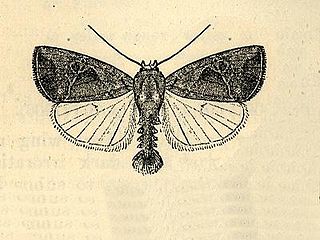Related Research Articles

Juan Cristóbal Gundlach, born Johannes Christoph Gundlach was a Cuban naturalist and taxonomist.
Robert W. Gundlach was an American physicist. He is most noted for his prolific contributions to the field of xerography, specifically the development of the modern photocopier. Gundlach helped transform the Haloid Company, a small photographic firm, into the thriving Xerox Corporation. Over the course of his 42 year career with the company, he contributed over 155 patents, making photocopying technology more affordable and practical. In 1966 Gundlach was named Xerox’s first Research Fellow, the highest non-managerial that could be achieved by a Xerox scientist. After his retirement in 1995, he was granted several patents associated with his hobbies, including a snow-making system and a special backpack.

Elaphria is a genus of moths of the family Noctuidae. The genus was erected by Jacob Hübner in 1818.

The festive midget is a species of moth of the family Noctuidae. It is found in eastern North America.

The pale-winged midget is a species of moth of the family Noctuidae. It is found from coast to coast in southern Canada and the northern United States.

Elaphria nucicolora, the sugarcane midget, is a moth of the family Noctuidae. The species was first described by Achille Guenée in 1852. It is found from the south-eastern United States, through Guadeloupe, Jamaica and Puerto Rico to tropical South America. It is also present on the Hawaiian islands of Oahu, Maui and Hawaii.

Elaphria agrotina is a moth of the family Noctuidae first described by Achille Guenée in 1852. It is found from North America, through Central America, the Antilles and Cuba to Brazil and Argentina.
Correbidia terminalis is a moth in the subfamily Arctiinae. It was described by Francis Walker in 1856. It is found from Mexico through Central America and Cuba and Puerto Rico to South America.

Baniana relapsa is a species of moth of the family Erebidae. It is found on the Antilles.

Eublemma cinnamomea is a species of moth of the family Erebidae first described by Gottlieb August Wilhelm Herrich-Schäffer in 1868. It is widespread in the New World tropics from the southern United States south to Argentina.

Robinsonia dewitzi is a moth in the family Erebidae first described by Juan Gundlach in 1881. It is found in Mexico, Costa Rica, Guatemala, Trinidad, Cuba, the Dominican Republic, the Guyanas, Brazil, Venezuela, Paraguay, Peru and Ecuador.
Eublemma recta, the straight-lined seed moth, is a moth of the family Erebidae. The species was first described by Achille Guenée in 1852. It is found in the United States from South Carolina to Florida and west to Texas. It is also found south to Argentina, on Cuba, Jamaica and Puerto Rico.
Epidromia lienaris is a moth of the family Erebidae first described by Jacob Hübner in 1823. It is found from southern Florida and Arizona southward through the Caribbean and Central America to Peru and Brazil and the Galápagos Islands.
Gonodes trapezoides is a moth of the family Noctuidae first described by Gottlieb August Wilhelm Herrich-Schäffer in 1868. It is found on Cuba.
Ernst Gundlach (1834–1908) was a German-American inventor specialising in the design of optical instruments.

Elaphria chalcedonia, the chalcedony midget moth, is a moth of the family Noctuidae. It is found in North America, where it has been recorded from the eastern United States, from Maine to Florida, west to Texas and north to Wisconsin. It is also found in Jamaica, Guadeloupe, Saint Martin, Puerto Rico and Central America. It was described by Jacob Hübner in 1808.

Blake's Wood & Lingwood Common is a 93.2 hectare biological Site of Special Scientific Interest in Danbury in Essex. It is owned by the National Trust and the local planning authority is Chelmsford City Council.

Elaphria cornutinus is a species of moth in the family Noctuidae. It was described by Sandra V. Saluke and Michael G. Pogue in 2000 and is found in North America, where it has been recorded from south-eastern United States.

Elaphria exesa, the exesa midget moth, is a species of cutworm or dart moth in the family Noctuidae. It is found in North America.
References
- ↑ Becker, Vitor O. (2002). "The Noctuoidea (Lepidoptera) from Cuba described by Herrich-Schäffer and Gundlach in the Gundlach Collection, Havana" (PDF). Revista Brasileira de Zoologia. 19 (2): 349–391. Archived (PDF) from the original on November 29, 2012.
| This Caradrinini-related article is a stub. You can help Wikipedia by expanding it. |